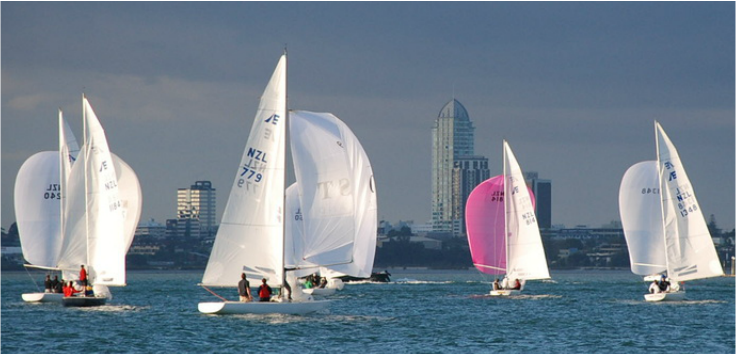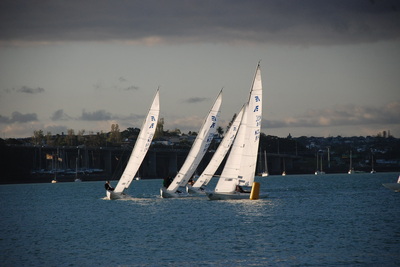|
Etchells New Zealand Tee-Shirts are now available here in a variety of men's and women's sizes.
• 180 GSM 100% Combed Cotton • Shoulder to shoulder tape • Fabric pre-shrunk to minimise shrinkage • Double needle bottom hem and sleeves • Side seamed for a tailored fit Free Shipping for orders over $100. All proceeds to Aucklands Etchells Fleet. These shirts will also be available for sale at next week's Invitational
1 Comment
HOPE SPRINGSFeng Shui (1248) celebrated the return of Andrew Wills with two wins on a light, flat course to take second place overall in the Series after two flights. Both Feng Shui (1248) and Valsheda II (950) showed an extra turn of speed through excellent set-up, sail-trim and boat-handling. However, the results show that remaining fleet is not too far behind and the series should remain close. Results here (flight) and here (series). INVITATIONALA reminder that the Etchells Invitational is on 4th November. This is an opportunity for anyone interested in Etchells sailing to get aboard and go racing.
Be sure to come along on the night - and please extend this invitation to anyone you know who might be interested - all are welcome. This is the first in a series of THREE THINGS to remember for various aspects of racing. It seems appropriate to begin with starting. pick your spotThe key is to decide on a spot to aim at before the 5 minute gun. You are allowed to change your mind, but don't procrastinate. Your preferred position will depend upon a number of factors, including tide, line bias, the conditions and the nature of the fleet. Some fleets (including the Etchells) have a tendency to crowd the committee boat and this can create a chaotic hairball that will quickly undo the best-laid plans. Even if the line is biased, a boat-end start (i.e. right at the boat) is a high-risk strategy: stuff it up and you have nowhere to go but backwards. Until you are confident of your set up and acceleration (of which more below) you should try to avoid crowds and concentrate on your own start. Having picked a spot (let's say, three-quarters to the boat), aim to be some way to the right of that spot, on starboard tack, early enough to set up and protect your patch. Some prefer to cruise below the line on port tack, identify a suitable hole in approximately the right place - and tack into it. Others prefer to set up well back from the line and drift forward. In either case, make sure that the hole you end up with is, on the one hand, big enough to allow you to bear away for acceleration, but, on the other hand, not too big to protect... protect your patchYou want to create a hole to leeward into which you will bear away for speed just before the start. You create and protect this hole by luffing (or threatening to luff) boats to windward. However, don't be greedy: if that hole is too big, you will tempt others to take it. Deter poachers by 'using your elbows' and taking up space: rotate your boat to face the pin, but without accelerating down the line (i.e. trim the jib, but not the main, then let them both flap). Use sail trim to maintain and protect your position relative to the boats on either side and don't be squeezed out the back like a bar of soap. accelerate quicklyAcceleration is the key to capitalizing on the viable position that you have worked to create. inside the last 30 seconds or so, try to keep the boat at or below the close-hauled angle, so that you all you need to do is trim-on to accelerate. Using the rudder is slow.
Just as soon as you can (based on your assessment of time and distance to the line), trim-on, hit the rail and go for it. This is one technique that is critically important to a great start and yet easy to practice any time, anywhere. long time no seaThe season opened with perfect conditions for the fleet of 7 early-birds, including newcomer Maverick (1077) and a welcome smattering of new faces throughout.
Pelle Petersson, who has recently acquired Verity (241) took to the sharp end of Tortuga (779) to learn the knitting - but hopes to take the con on his own boat before too long. The opening start was mercifully free of unwanted drama, despite some familiar crowding at the boat end. A turning tide kept things interesting and even on the (necessarily) short course and there was little to separate the fleet at the top mark. Proving that it pays to read the NOR, the majority of the fleet then turned confidently to the blue bottom mark and took the lead. There remains some question as to who did and who did not sail the correct course (and the results may need to be amended), but suffice it to say that your correspondent is feeling relatively smug about this one. An efficient RNZYS managed to get off three races in quick succession before the light failed, but it was evident from smiling faces on the dock and at the bar that all were eager for more of the same. As Al Gair put it "it's been a long time between drinks". Many thanks to Patch Graham for some excellent photos, a selection of which are posted below. Results here (flight) and here (series) |
AuthorAlex Webster is Auckland Fleet Captain and runs this website, so blame him. Archives
February 2019
Categories
All
|















 RSS Feed
RSS Feed
